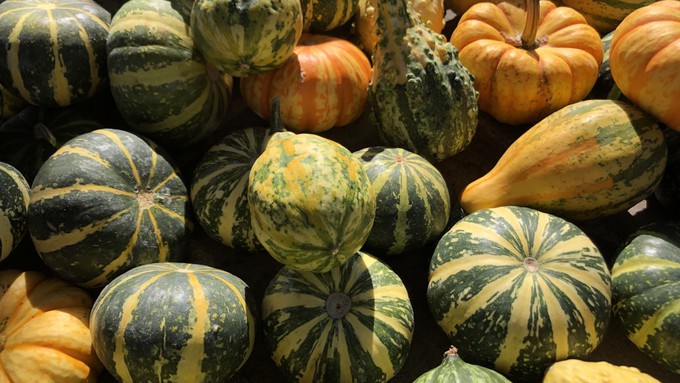
Fall is finally in the air (and so is fire danger)

It's decorative gourd season! Harvest your squash, gourds and pumpkins for decor galore. Kathy Morrison
After a string of summerlike days, gusty conditions are expected to blow through Northern California and drop temperatures by double digits. With those winds comes increased fire danger.
“A significant pattern change will take place in the West this weekend with a major storm system digging and carving through the region,” says the National Weather Service. “A number of weather hazards are expected from high winds for a large chunk of the West to the first heavy mountain snowfall of the season for the northern and central Rockies. Also, temperatures are likely to be well below normal this weekend and all of next week.”
That system definitely will affect Sacramento’s weather week. We start out windy and turn chilly.
Noon to 10 p.m. Sunday, a high wind warning will be in effect for much of the Sacramento Valley and surrounding areas with winds of 15 to 25 mph forecast, says the Sacramento NWS bulletin. Locally, gusts of 30 to 40 mph could hit Sunday afternoon and evening.
Coupled with low humidity, those gusty winds increase fire danger – all it takes is one spark. Put away power tools for another day, especially if working around tall dry grass.
Also be on the lookout for falling limbs (or whole trees). Months of drought have weakened root systems as well as branches. A strong gust may be just enough push to bring a stressed tree down.
Once the winds recede, Sacramento will see some great gardening weather, albeit no rain. Right now, the weather service expects us to stay dry. There’s a “slight chance” of showers late Tuesday night, but otherwise no precipitation is in the forecast.
Through Friday, daytime highs will be pleasantly in the low 70s – below normal for mid October (which averages highs of 78), but 20 degrees cooler than last week. Overnight lows will start dipping into the mid 40s; that will bring out fall colors in trees and finish off the tomatoes.
* Plant trees, shrubs and perennials. Remember to deep-water any transplants.
* Plant seeds for many flowers directly into the garden, including cornflower, nasturtium, nigella, poppy, portulaca, sweet pea and stock.
* Plant seeds for radishes, bok choy, mustard, spinach and peas.
* Plant garlic and onions.
* Set out cool-weather bedding plants, including calendula, pansy, snapdragon, primrose and viola.
* Reseed and feed the lawn. Work on bare spots.
* Dig up corms and tubers of gladioluses, dahlias and tuberous begonias after the foliage dies. Clean and store in a cool, dry place.
* Treat azaleas, gardenias and camellias with chelated iron if leaves are yellowing between the veins.
* Clean up the remains of the summer vegetable garden and compost disease-free foliage.
* Harvest pumpkins and winter squash.
Previous posts on fall planting:
California's favorite winter vegetable to grow: Broccoli
Fallen leaves: Turn mess into mulch
Comments
0 comments have been posted.Sacramento Digs Gardening to your inbox.
Food in My Back Yard Series
April 29: What's (already) wrong with my tomato plants?
April 22: Should you stock up on fertilizer? (Yes!)
April 15: Grow culinary herbs in containers
April 8: When to plant summer vegetables
April 1: Don't be fooled by these garden myths
March 25: Fertilizer tips: How to 'feed' your vegetables for healthy growth
March 18: Time to give vegetable seedlings some more space
March 11: Ways to win the fight against weeds
March 4: Potatoes from the garden
Feb. 25: Plant a fruit tree now -- for later
Feb. 18: How to squeeze more food into less space
Feb. 11: When to plant? Consider staggering your transplants
Feb. 4: Starting in seed starting
Sites We Like
Garden Checklist for week of May 4
Enjoy this spring weather – and get gardening!
* Plant, plant, plant! It’s prime planting season in the Sacramento area. Time to set out those tomato transplants along with peppers and eggplants. Pinch off any flowers on new transplants to make them concentrate on establishing roots instead of setting premature fruit.
* Direct-seed melons, cucumbers, summer squash, corn, radishes, pumpkins and annual herbs such as basil.
* Harvest cabbage, lettuce, peas and green onions.
* In the flower garden, direct-seed sunflowers, cosmos, salvia, zinnias, marigolds, celosia and asters. (You also can transplant seedlings for many of the same flowers.)
* Plant dahlia tubers. Other perennials to set out include verbena, coreopsis, coneflower and astilbe.
* Transplant petunias, marigolds and perennial flowers such as astilbe, columbine, coneflowers, coreopsis, dahlias, rudbeckia and verbena.
* Keep an eye out for slugs, snails, earwigs and aphids that want to dine on tender new growth.
* Feed summer bloomers with a balanced fertilizer.
* For continued bloom, cut off spent flowers on roses as well as other flowering plants.
* Add mulch to the garden to maintain moisture. Mulch also cuts down on weeds. But don’t let it mound around the stems or trunks of trees or shrubs. Leave about a 6-inch to 1-foot circle to avoid crown rot or other problems.